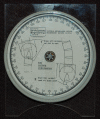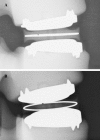Radiographic total disc replacement angle measurement accuracy using the Oxford Cobbometer: precision and bias
- PMID: 18496719
- PMCID: PMC2518759
- DOI: 10.1007/s00586-008-0686-x
Radiographic total disc replacement angle measurement accuracy using the Oxford Cobbometer: precision and bias
Abstract
Total disc replacement (TDR) clinical success has been reported to be related to the residual motion of the operated level. Thus, accurate measurement of TDR range of motion (ROM) is of utmost importance. One commonly used tool in measuring ROM is the Oxford Cobbometer. Little is known however on its accuracy (precision and bias) in measuring TDR angles. The aim of this study was to assess the ability of the Cobbometer to accurately measure radiographic TDR angles. An anatomically accurate synthetic L4-L5 motion segment was instrumented with a CHARITE artificial disc. The TDR angle and anatomical position between L4 and L5 was fixed to prohibit motion while the motion segment was radiographically imaged in various degrees of rotation and elevation, representing a sample of possible patient placement positions. An experienced observer made ten readings of the TDR angle using the Cobbometer at each different position. The Cobbometer readings were analyzed to determine measurement accuracy at each position. Furthermore, analysis of variance was used to study rotation and elevation of the motion segment as treatment factors. Cobbometer TDR angle measurements were most accurate (highest precision and lowest bias) at the centered position (95.5%), which placed the TDR directly inline with the x-ray beam source without any rotation. In contrast, the lowest accuracy (75.2%) was observed in the most rotated and off-centered view. A difference as high as 4 degrees between readings at any individual position, and as high as 6 degrees between all the positions was observed. Furthermore, the Cobbometer was unable to detect the expected trend in TDR angle projection with changing position. Although the Cobbometer has been reported to be reliable in different clinical applications, it lacks the needed accuracy to measure TDR angles and ROM. More accurate ROM measurement methods need to be developed to help surgeons and researchers assess radiological success of TDRs.
Figures




Similar articles
-
Consequences of patient position in the radiographic measurement of artificial disc replacement angles.Eur Spine J. 2008 Jan;17(1):30-5. doi: 10.1007/s00586-007-0486-8. Epub 2007 Sep 11. Eur Spine J. 2008. PMID: 17846802 Free PMC article.
-
Segmental contribution toward total lumbar range of motion in disc replacement and fusions: a comparison of operative and adjacent levels.Spine (Phila Pa 1976). 2009 Nov 1;34(23):2510-7. doi: 10.1097/BRS.0b013e3181af2622. Spine (Phila Pa 1976). 2009. PMID: 19927100 Clinical Trial.
-
Measurement error of lumbar total disc replacement range of motion.Spine (Phila Pa 1976). 2006 May 1;31(10):E291-7. doi: 10.1097/01.brs.0000216452.54421.ea. Spine (Phila Pa 1976). 2006. PMID: 16648735
-
A prospective, randomized, multicenter Food and Drug Administration investigational device exemption study of lumbar total disc replacement with the CHARITE artificial disc versus lumbar fusion: part II: evaluation of radiographic outcomes and correlation of surgical technique accuracy with clinical outcomes.Spine (Phila Pa 1976). 2005 Jul 15;30(14):1576-83; discussion E388-90. doi: 10.1097/01.brs.0000170561.25636.1c. Spine (Phila Pa 1976). 2005. PMID: 16025025 Clinical Trial.
-
Response of Charité total disc replacement under physiologic loads: prosthesis component motion patterns.Spine J. 2005 Nov-Dec;5(6):590-9. doi: 10.1016/j.spinee.2005.06.015. Spine J. 2005. PMID: 16291097
Cited by
-
We Need to Talk about Lumbar Total Disc Replacement.Int J Spine Surg. 2018 Aug 3;12(2):201-240. doi: 10.14444/5029. eCollection 2018 Apr. Int J Spine Surg. 2018. PMID: 30276080 Free PMC article.
References
-
- Carman DL, Browne RH, Birch JG. Measurement of scoliosis and kyphosis radiographs. Intraobserver and interobserver variation. J Bone Joint Surg Am. 1990;72:328–333. - PubMed
Publication types
MeSH terms
LinkOut - more resources
Full Text Sources

